

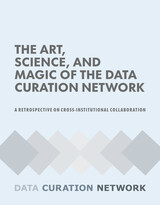
The Art, Science, and Magic of the Data Curation Network: A Retrospective on Cross Institutional Collaboration captures the results of a project retrospective meeting and describes the necessary components of the DCN’s sustained collaboration in the hopes that the insights will be of use to other collaborative efforts. In particular, the authors describe the successes of the community and challenges of launching a cross-institutional network. Additionally, this publication details the administrative, tool-based, and trust-based structures necessary for establishing this community, the “radical collaboration” that is the cornerstone of the DCN, and potential future collaborations to address shared challenges in libraries and research data management. This in-depth case study provides an overview of the critical work of launching a collaborative network and transitioning to sustainability. This publication will be of special interest to research librarians, data curators, and anyone interested in academic community building.


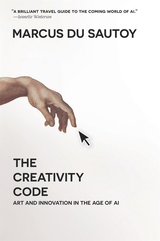
“A brilliant travel guide to the coming world of AI.”
—Jeanette Winterson
What does it mean to be creative? Can creativity be trained? Is it uniquely human, or could AI be considered creative?
Mathematical genius and exuberant polymath Marcus du Sautoy plunges us into the world of artificial intelligence and algorithmic learning in this essential guide to the future of creativity. He considers the role of pattern and imitation in the creative process and sets out to investigate the programs and programmers—from Deep Mind and the Flow Machine to Botnik and WHIM—who are seeking to rival or surpass human innovation in gaming, music, art, and language. A thrilling tour of the landscape of invention, The Creativity Code explores the new face of creativity and the mysteries of the human code.
“As machines outsmart us in ever more domains, we can at least comfort ourselves that one area will remain sacrosanct and uncomputable: human creativity. Or can we?…In his fascinating exploration of the nature of creativity, Marcus du Sautoy questions many of those assumptions.”
—Financial Times
“Fascinating…If all the experiences, hopes, dreams, visions, lusts, loves, and hatreds that shape the human imagination amount to nothing more than a ‘code,’ then sooner or later a machine will crack it. Indeed, du Sautoy assembles an eclectic array of evidence to show how that’s happening even now.”
—The Times
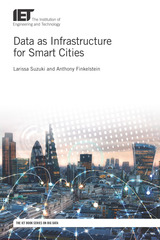
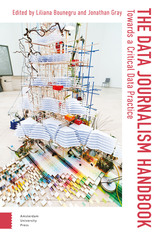
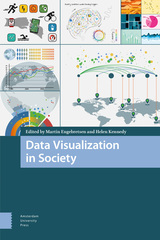
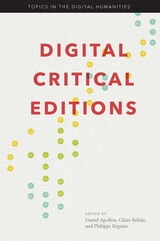
Provocative yet sober, Digital Critical Editions examines how transitioning from print to a digital milieu deeply affects how scholars deal with the work of editing critical texts. On one hand, forces like changing technology and evolving reader expectations lead to the development of specific editorial products, while on the other hand, they threaten traditional forms of knowledge and methods of textual scholarship.
Using the experiences of philologists, text critics, text encoders, scientific editors, and media analysts, Digital Critical Editions ranges from philology in ancient Alexandria to the vision of user-supported online critical editing, from peer-directed texts distributed to a few to community-edited products shaped by the many. The authors discuss the production and accessibility of documents, the emergence of tools used in scholarly work, new editing regimes, and how the readers' expectations evolve as they navigate digital texts. The goal: exploring questions such as, What kind of text is produced? Why is it produced in this particular way?
Digital Critical Editions provides digital editors, researchers, readers, and technological actors with insights for addressing disruptions that arise from the clash of traditional and digital cultures, while also offering a practical roadmap for processing traditional texts and collections with today's state-of-the-art editing and research techniques thus addressing readers' new emerging reading habits.

The Pyramids on the Giza Plateau represent perhaps the most famous archaeological site in the world, capturing on tomb walls frozen moments from almost every aspect of life in ancient Egypt. This book, by one of the foremost experts on the history of Giza, explores new approaches to “cataloging” the site, highlighting efforts at the Museum of Fine Arts Boston and Harvard University.
The site experienced its first “golden age” as the burial place of three pharaohs of the Egyptian Old Kingdom (Dynasty 4, ca. 2640–2510 BCE). A second golden age came almost five millennia later, when the first modern excavators applied their newly devised archaeological craft to the Giza Plateau. Now, with the advent of many new technologies in the twenty-first century, the Giza Necropolis is available in two, three, and even four dimensions. Children and specialized scholars alike may study the material culture of this ancient civilization from afar, often with greater access than could be achieved in person. However, these new approaches do raise questions: Does 3-D modeling and animation truly improve scholarly comprehension and interpretation? Can interacting with animations still be called scholarship? Where is the border between academic knowledge and mere entertainment?
Through specific case studies and an in-depth history of this important project, Peter Der Manuelian provides an excellent model for other digital visualization initiatives. He also offers more general philosophical reflection on the nature of visualization in archaeology and speculates about emerging technologies and how they may be useful in the future.

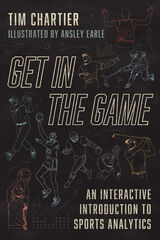
In 2013, NBA point guard Steph Curry wowed crowds when he sunk 11 out of 13 three-pointers for a game total of 54 points—only seven other players, including Michael Jordan and Kobe Bryant, had scored more in a game at Madison Square Garden. Four years later, the University of Connecticut women’s basketball team won its hundredth straight game, defeating South Carolina 66–55. And in 2010, one forecaster—an octopus named Paul—correctly predicted the outcome of all of Germany’s matches in the FIFA World Cup. These are surprising events—but are they truly improbable?
In Get in the Game, mathematician and sports analytics expert Tim Chartier helps us answer that question—condensing complex mathematics down to coin tosses and dice throws to give readers both an introduction to statistics and a new way to enjoy sporting events. With these accessible tools, Chartier leads us through modeling experiments that develop our intuitive sense of the improbable. For example, to see how likely you are to beat Curry’s three-pointer feat, consider his 45.3 percent three-point shooting average in 2012–13. Take a coin and assume heads is making the shot (slightly better than Curry at a fifty percent chance). Can you imagine getting heads eleven out of thirteen times? With engaging exercises and fun, comic book–style illustrations by Ansley Earle, Chartier’s book encourages all readers—including those who have never encountered formal statistics or data simulations, or even heard of sports analytics, but who enjoy watching sports—to get in the game.

In our current screen-saturated culture, we take in more information through visual means than at any point in history. The computers and smart phones that constantly flood us with images do more than simply convey information. They structure our relationship to information through graphical formats. Learning to interpret how visual forms not only present but produce knowledge, says Johanna Drucker, has become an essential contemporary skill.
Graphesis provides a descriptive critical language for the analysis of graphical knowledge. In an interdisciplinary study fusing digital humanities with media studies and graphic design history, Drucker outlines the principles by which visual formats organize meaningful content. Among the most significant of these formats is the graphical user interface (GUI)—the dominant feature of the screens of nearly all consumer electronic devices. Because so much of our personal and professional lives is mediated through visual interfaces, it is important to start thinking critically about how they shape knowledge, our behavior, and even our identity.
Information graphics bear tell-tale signs of the disciplines in which they originated: statistics, business, and the empirical sciences. Drucker makes the case for studying visuality from a humanistic perspective, exploring how graphic languages can serve fields where qualitative judgments take priority over quantitative statements of fact. Graphesis offers a new epistemology of the ways we process information, embracing the full potential of visual forms and formats of knowledge production.
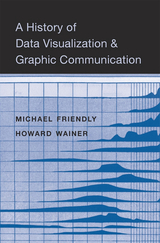
A comprehensive history of data visualization—its origins, rise, and effects on the ways we think about and solve problems.
With complex information everywhere, graphics have become indispensable to our daily lives. Navigation apps show real-time, interactive traffic data. A color-coded map of exit polls details election balloting down to the county level. Charts communicate stock market trends, government spending, and the dangers of epidemics. A History of Data Visualization and Graphic Communication tells the story of how graphics left the exclusive confines of scientific research and became ubiquitous. As data visualization spread, it changed the way we think.
Michael Friendly and Howard Wainer take us back to the beginnings of graphic communication in the mid-seventeenth century, when the Dutch cartographer Michael Florent van Langren created the first chart of statistical data, which showed estimates of the distance from Rome to Toledo. By 1786 William Playfair had invented the line graph and bar chart to explain trade imports and exports. In the nineteenth century, the “golden age” of data display, graphics found new uses in tracking disease outbreaks and understanding social issues. Friendly and Wainer make the case that the explosion in graphical communication both reinforced and was advanced by a cognitive revolution: visual thinking. Across disciplines, people realized that information could be conveyed more effectively by visual displays than by words or tables of numbers.
Through stories and illustrations, A History of Data Visualization and Graphic Communication details the 400-year evolution of an intellectual framework that has become essential to both science and society at large.
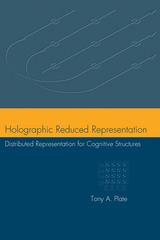
Holographic Reduced Representations (HRRs) are introduced here to model how the brain distributes each piece of information among thousands of neurons. It had been previously thought that the grammatical structure of a language cannot be encoded practically in a distributed representation, but HRRs can overcome the problems of earlier proposals. Thus this work has implications for psychology, neuroscience, linguistics, and computer science, and engineering.

The prefix “hyper” refers to multiplicity and abundance. More than a physical space, a hypercity is a real city overlaid with information networks that document the past, catalyze the present, and project future possibilities. Hypercities are always under construction.
Todd Presner, David Shepard, and Yoh Kawano put digital humanities theory into practice to chart the proliferating cultural records of places around the world. A digital platform transmogrified into a book, it explains the ambitious online project of the same name that maps the historical layers of city spaces in an interactive, hypermedia environment. The authors examine the media archaeology of Google Earth and the cultural–historical meaning of map projections, and explore recent events—the “Arab Spring” and the Fukushima nuclear power plant disaster—through social media mapping that incorporates data visualizations, photographic documents, and Twitter streams. A collaboratively authored and designed work, HyperCities includes a “ghost map” of downtown Los Angeles, polyvocal memory maps of LA’s historic Filipinotown, avatar-based explorations of ancient Rome, and hour-by-hour mappings of the Tehran election protests of 2009.
Not a book about maps in the literal sense, HyperCities describes thick mapping: the humanist project of participating and listening that transforms mapping into an ethical undertaking. Ultimately, the digital humanities do not consist merely of computer-based methods for analyzing information. They are a means of integrating scholarship with the world of lived experience, making sense of the past in the layered spaces of the present for the sake of the open future.
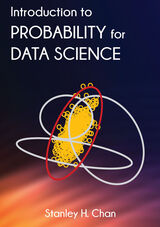
- Motivation: In the ocean of mathematical definitions, theorems, and equations, why should we spend our time on this particular topic but not another?
- Intuition: When going through the deviations, is there a geometric interpretation or physics beyond those equations?
- Implication: After we have learned a topic, what new problems can we solve?

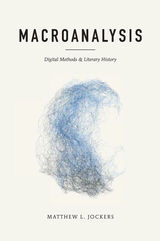


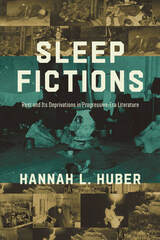
A turn-of-the-century influx of new technologies and the enormous impact of the electric light transformed not only individual sleeping habits but the ways American culture conceived and valued sleep. Hannah L. Huber analyzes the works of Henry James, Edith Wharton, Charles Chesnutt, and Charlotte Perkins Gilman to examine the literary response to the period’s obsession with wakefulness. As these writers blurred the separation of public and private space, their characters faced exhaustion in a modern world that permeated every moment of their lives with artificial light, traffic noise, and the social pressure to remain active at all hours. The implacable cultural clock and constant stress over physical limitations had an even greater impact on marginalized figures. Huber pays particular attention to how these writers rebutted Americans’ confidence in the body’s ability to conquer sleep with vivid portraits of the devastating consequences of sleep disruption and deprivation.
The author also provides a website and text visualization tool that offers readers an interdisciplinary, deconstructed analysis of the book’s primary texts. The website can be found at: https://sleepfictions.org/sleep/scalar/index
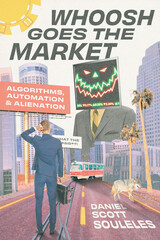
Markets are messy, and no one knows this better than traders who work tirelessly to predict what they will do next. In Whoosh Goes the Market, Daniel Scott Souleles takes us into the day-to-day experiences of a team at a large trading firm, revealing what it’s actually like to make and lose money on contemporary capital markets.
The traders Souleles shadows have mostly moved out of the pits and now work with automated, glitch-prone computer systems. They remember the days of trading manually, and they are suspicious of algorithmically driven machine-learning systems. Openly musing about their own potential extinction, they spend their time expressing fear and frustration in profanity-laced language. With Souleles as our guide, we learn about everything from betting strategies to inflated valuations, trading swings, and market manipulation. This crash course in contemporary finance vividly reveals the existential anxiety at the evolving front lines of American capitalism.
READERS
Browse our collection.
PUBLISHERS
See BiblioVault's publisher services.
STUDENT SERVICES
Files for college accessibility offices.
UChicago Accessibility Resources
home | accessibility | search | about | contact us
BiblioVault ® 2001 - 2024
The University of Chicago Press









